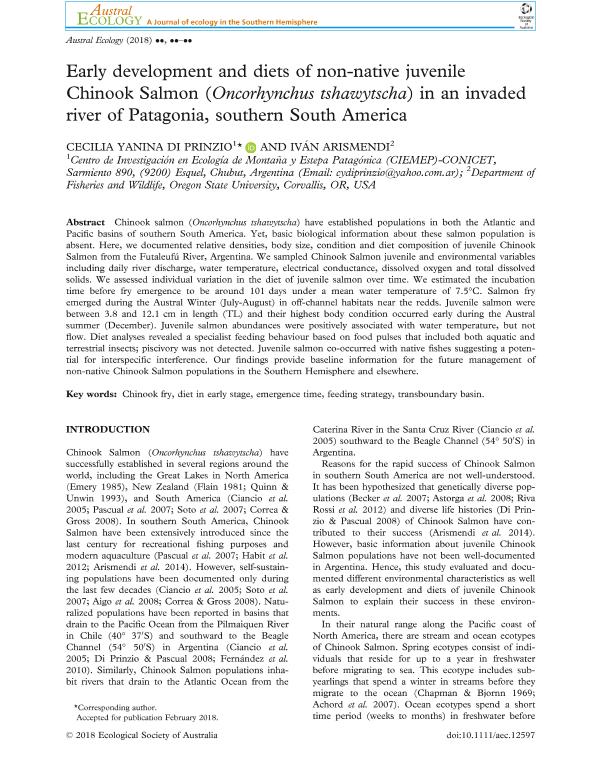Mostrar el registro sencillo del ítem
dc.contributor.author
Di Prinzio, Cecilia Yanina

dc.contributor.author
Arismendi, Iván
dc.date.available
2019-10-22T18:18:59Z
dc.date.issued
2018-11
dc.identifier.citation
Di Prinzio, Cecilia Yanina; Arismendi, Iván; Early development and diets of non-native juvenile Chinook Salmon (Oncorhynchus tshawytscha) in an invaded river of Patagonia, southern South America; Wiley Blackwell Publishing, Inc; Austral Ecology; 43; 7; 11-2018; 732-741
dc.identifier.issn
1442-9985
dc.identifier.uri
http://hdl.handle.net/11336/86947
dc.description.abstract
Chinook salmon (Oncorhynchus tshawytscha) have established populations in both the Atlantic and Pacific basins of southern South America. Yet, basic biological information about these salmon population is absent. Here, we documented relative densities, body size, condition and diet composition of juvenile Chinook Salmon from the Futaleufú River, Argentina. We sampled Chinook Salmon juvenile and environmental variables including daily river discharge, water temperature, electrical conductance, dissolved oxygen and total dissolved solids. We assessed individual variation in the diet of juvenile salmon over time. We estimated the incubation time before fry emergence to be around 101 days under a mean water temperature of 7.5°C. Salmon fry emerged during the Austral Winter (July-August) in off-channel habitats near the redds. Juvenile salmon were between 3.8 and 12.1 cm in length (TL) and their highest body condition occurred early during the Austral summer (December). Juvenile salmon abundances were positively associated with water temperature, but not flow. Diet analyses revealed a specialist feeding behaviour based on food pulses that included both aquatic and terrestrial insects; piscivory was not detected. Juvenile salmon co-occurred with native fishes suggesting a potential for interspecific interference. Our findings provide baseline information for the future management of non-native Chinook Salmon populations in the Southern Hemisphere and elsewhere.
dc.format
application/pdf
dc.language.iso
eng
dc.publisher
Wiley Blackwell Publishing, Inc

dc.rights
info:eu-repo/semantics/openAccess
dc.rights.uri
https://creativecommons.org/licenses/by-nc-sa/2.5/ar/
dc.subject
CHINOOK FRY
dc.subject
DIET IN EARLY STAGE
dc.subject
EMERGENCE TIME
dc.subject
FEEDING STRATEGY
dc.subject
TRANSBOUNDARY BASIN
dc.subject.classification
Ecología

dc.subject.classification
Ciencias Biológicas

dc.subject.classification
CIENCIAS NATURALES Y EXACTAS

dc.title
Early development and diets of non-native juvenile Chinook Salmon (Oncorhynchus tshawytscha) in an invaded river of Patagonia, southern South America
dc.type
info:eu-repo/semantics/article
dc.type
info:ar-repo/semantics/artículo
dc.type
info:eu-repo/semantics/publishedVersion
dc.date.updated
2019-10-15T14:57:57Z
dc.journal.volume
43
dc.journal.number
7
dc.journal.pagination
732-741
dc.journal.pais
Reino Unido

dc.journal.ciudad
Londres
dc.description.fil
Fil: Di Prinzio, Cecilia Yanina. Consejo Nacional de Investigaciones Científicas y Técnicas. Centro Científico Tecnológico Conicet - Patagonia Norte. Centro de Investigación Esquel de Montaña y Estepa Patagóica. Universidad Nacional de la Patagonia "San Juan Bosco". Facultad de Ciencias Naturales - Sede Esquel. Centro de Investigación Esquel de Montaña y Estepa Patagónica; Argentina
dc.description.fil
Fil: Arismendi, Iván. State University of Oregon; Estados Unidos
dc.journal.title
Austral Ecology

dc.relation.isreferencedin
info:eu-repo/semantics/reference/url/https://onlinelibrary.wiley.com/toc/14429993/2018/43/7
dc.relation.alternativeid
info:eu-repo/semantics/altIdentifier/doi/http://dx.doi.org/10.1111/aec.12597
dc.relation.alternativeid
info:eu-repo/semantics/altIdentifier/url/https://onlinelibrary.wiley.com/doi/abs/10.1111/aec.12597
Archivos asociados
